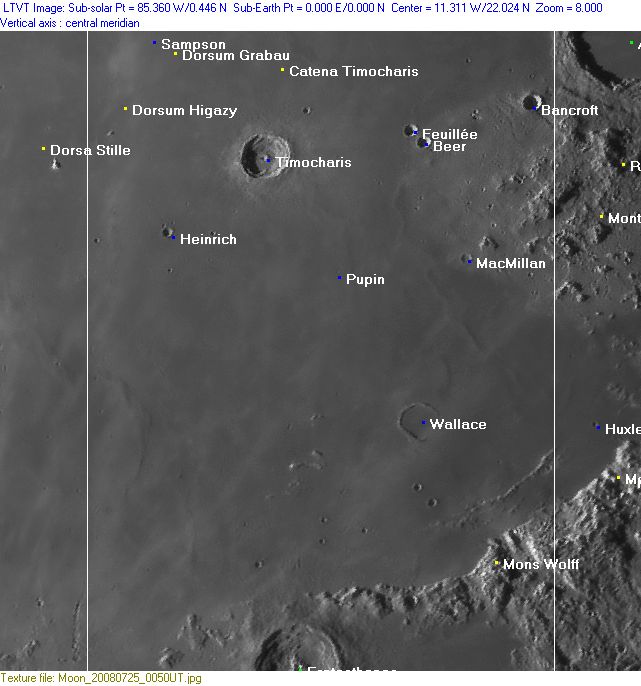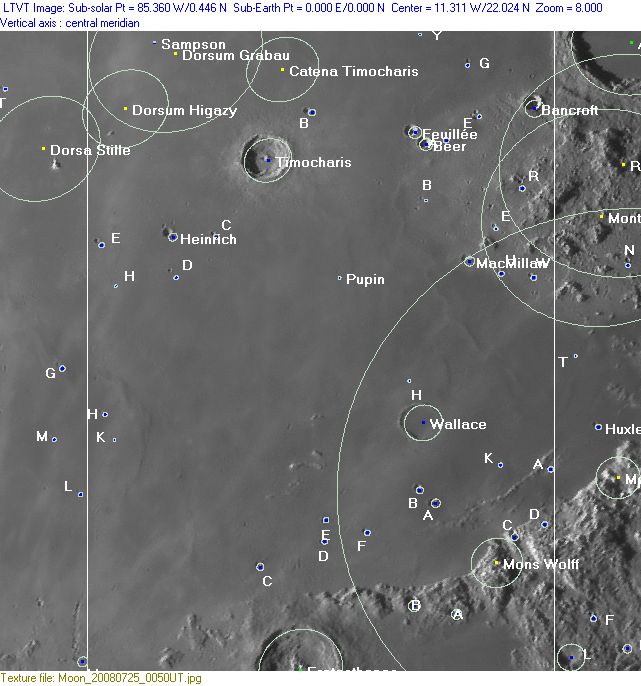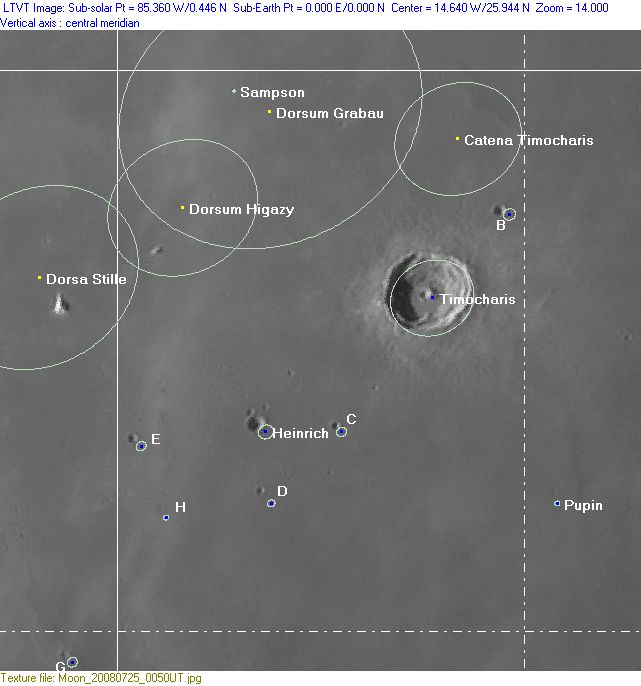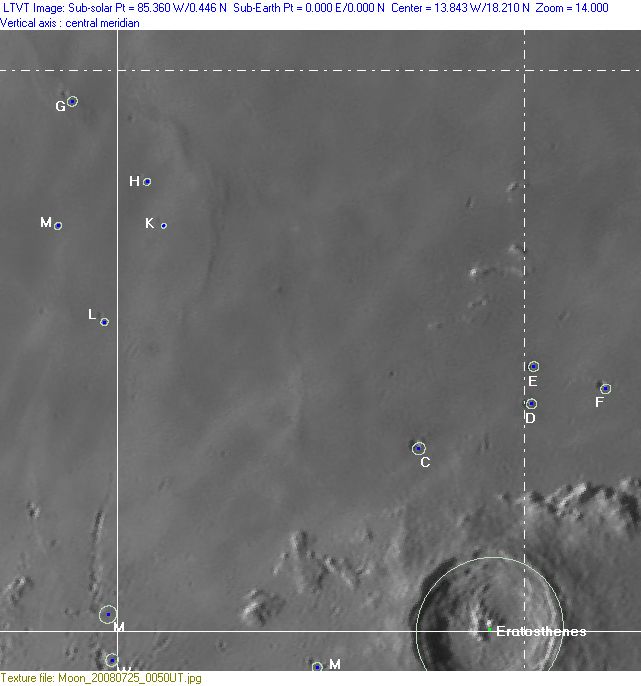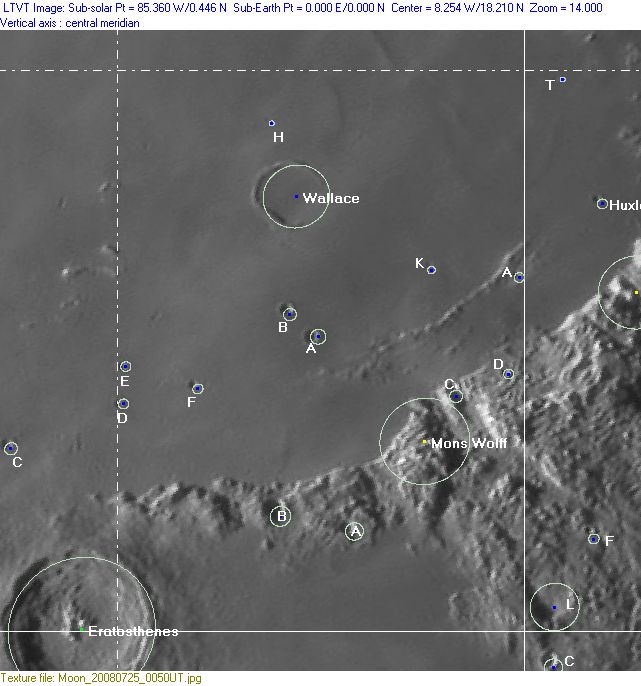Difference between revisions of "Rükl 21"
(Created page with "<div id="content_view" class="wiki" style="display: block"> =Rükl Zone 21 - TIMOCHARIS= <br /> Neighboring maps on the [http://the-moon.us/wiki/R%C3%BCkl%20Index%20Map Rü...") |
|||
| Line 2: | Line 2: | ||
=Rükl Zone 21 - TIMOCHARIS= | =Rükl Zone 21 - TIMOCHARIS= | ||
<br /> Neighboring maps on the [http://the-moon.us/wiki/R%C3%BCkl%20Index%20Map Rükl Nearside Map]:<br /> <div id="toc"> | <br /> Neighboring maps on the [http://the-moon.us/wiki/R%C3%BCkl%20Index%20Map Rükl Nearside Map]:<br /> <div id="toc"> | ||
| − | + | ||
| − | |||
{| class="wiki_table" | {| class="wiki_table" | ||
| | | | ||
| Line 89: | Line 88: | ||
<br /> | <br /> | ||
==WARNING:== | ==WARNING:== | ||
| − | Those who want to create a large assembled moonmap of Antonin Rukl's 76 small charts (of the moon's near side from his ''Atlas of the Moon'') shall notice a shift of about one millimeter to the left at the northern half of '''Eratosthenes''' (on the lower margin of chart 21). The southern half of '''Eratosthenes''' (on the upper margin of chart 32) shows a shift of about one millimeter to the right. If you want to make enlarged photocopies of all 76 charts (say: at 200 percent of the original prints) keep in mind that the shift at '''Eratosthenes''' will be <u>'''4'''</u> millimeters! (almost <u>'''half a centimeter'''</u>). Crater '''Manilius''' (on charts 23 and 34) shows the same phenomenon.<br /> <span class="membersnap">- | + | Those who want to create a large assembled moonmap of Antonin Rukl's 76 small charts (of the moon's near side from his ''Atlas of the Moon'') shall notice a shift of about one millimeter to the left at the northern half of '''Eratosthenes''' (on the lower margin of chart 21). The southern half of '''Eratosthenes''' (on the upper margin of chart 32) shows a shift of about one millimeter to the right. If you want to make enlarged photocopies of all 76 charts (say: at 200 percent of the original prints) keep in mind that the shift at '''Eratosthenes''' will be <u>'''4'''</u> millimeters! (almost <u>'''half a centimeter'''</u>). Crater '''Manilius''' (on charts 23 and 34) shows the same phenomenon.<br /> <span class="membersnap">- DannyCaes <small>Jan 24, 2016</small></span><br /> <br /> |
---- | ---- | ||
| − | + | </div> | |
Revision as of 16:48, 15 April 2018
Contents
Rükl Zone 21 - TIMOCHARIS
Neighboring maps on the Rükl Nearside Map:
| 21 |
||
Photographic Map
(This map is based on an Earth-based photograph that has been computer-corrected to zero libration. The vertical white lines indicate the left and right boundaries of the Rükl rectangle)
Background image source
Named Features
- Bancroft (once called Gant by H.P.Wilkins).
- Beaded ridge (a nickname from H.G.Boutell for the thin row of hills between Mons Wolff and Wallace, see Sky & Telescope - january 1953; Queen of the Untraveled Seas).
- Beer
- Catena Beer (an unofficial name from D.Caes for the officially unnamed chain of craterlets just east-southeast of the couple Beer-Feuillee, once called Fossa Archimedes, see Lunar Topographic Orthophotomap 41-A4).
- Catena Timocharis
- Dorsum Beer (an unofficial name from D.Caes for the wrinkle ridge south-southwest of Beer).
- Dorsum Grabau
- Dorsum Higazy
- East of Pytheas arc (a rather clumsy unofficial name from D.Caes for the curved wrinkle ridge southeast of Dorsum Lambert, east of Pytheas) (for Pytheas see Chart 20).
- Eratosthenes (Van Langren's Haro, J.Hewelcke's Insula Vulcania) (this is the pronounced crater at the lower margin of Chart 21, near the western end of Montes Apenninus) (see also Additional Information below) (note: on the Strasbourg forgery of Van Langren's map this crater was called Campinii).
- Feuillée
- Heinrich
- Kovalevsky (a discontinued name for Timocharis B, northeast of Timocharis itself, see Lunar Topographic Orthophotomap 40-B3).
- Lacus Marinus (J.Hewelcke's disallowed name for the region west of the IAU's Archimedes).
- MacMillan
- Mare Imbrium (Van Langren's Mare Austriacum, J.Hewelcke's Mare Mediterraneum) (the flat looking region depicted on most of Chart 21).
- Mons Eryx (J.Hewelcke's disallowed name for the ejecta rays north-northeast from Copernicus).
- Mons Myconius (J.Hewelcke's disallowed name for the ejecta ray northeast from Copernicus).
- Mons Serao (a discontinued? IAU name).
- Mons Wolff
- Montes Apenninus (near the lower right corner of Chart 21).
- Montes Archimedes (the western part of it, south of the bowl-shaped crater Bancroft) (once called Montes Lomonosov, see A.V.Markov's book The Moon).
- Prom. Circaeum (J.Hewelcke's disallowed name for the western part of Montes Archimedes).
- Pupin (what was the scientific reason to give such an insignificant little craterlet an officially recognized name?).
- Sampson (and the Gang-of-Four immediately east of Sampson itself) (the Gang-of-Four is a nickname from D.Caes).
- Sinus Athlanticus (Van Langren's disallowed name for the region southeast of Timocharis, northeast of Eratosthenes) (J.Hewelcke's Sinus Paestanus).
- Sixteen-West ray (a nickname by D.Caes for the easternmost one of the two pronounced northern rays from Copernicus) (running at approximately 16 degrees West across the southern part of Mare Imbrium).
- Southwest of MacMillan ridge (a rather clumsy unofficial name from D.Caes for the southeastern continuation of Dorsum Beer).
- Timocharis (Van Langren's Gassendi, J.Hewelcke's Insula Corsica).
- Tiny white island (a nickname from Danny Caes for the officially unnamed hillock (or "island") east-southeast of Pytheas K) (this tiny hillock shows a high-albedo spot at its northern slope) (its pinpoint location is LAT: 19.00 / LON: -14.45) (see the LROC ACT-REACT QUICK MAP for several NAC close ups of it).
- Wallace
- Wallace hillocks (an unofficial name from D.Caes for the officially unnamed cluster of hillocks west-southwest of Wallace).
- Wallace ray (a nickname by D.Caes for the northeastern Copernicus ray which runs over Wallace in the southeastern part of Mare Imbrium) (the same as the Myconius Ray of Hevelius?).
Lettered Crater Locations
(click on the thumbnails to display full-sized images; use browser BACK button to return - the dashed white lines are the midpoints of the Rükl zones)
Full zone with lettered craters:
Lettered craters by quadrants:
| North West |
North East |
| South West |
South East |
Additional Information
- Other online descriptions of features in this Rükl map section:
WARNING:
Those who want to create a large assembled moonmap of Antonin Rukl's 76 small charts (of the moon's near side from his Atlas of the Moon) shall notice a shift of about one millimeter to the left at the northern half of Eratosthenes (on the lower margin of chart 21). The southern half of Eratosthenes (on the upper margin of chart 32) shows a shift of about one millimeter to the right. If you want to make enlarged photocopies of all 76 charts (say: at 200 percent of the original prints) keep in mind that the shift at Eratosthenes will be 4 millimeters! (almost half a centimeter). Crater Manilius (on charts 23 and 34) shows the same phenomenon.
- DannyCaes Jan 24, 2016
